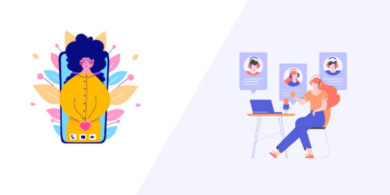It’s Sunday afternoon, and *Phil, Head of HR at his workplace, is taping off common working areas, sticking arrows onto corridor carpets, and marking circles around desks. “It feels like something out of the Twilight Zone. If someone had told me I would be doing this as part of my job a few months ago, I never would have believed them.” It’s a reality many HR leaders face as they work to combat the rapid onset COVID-19 has had on their workforce.
But while the arrows, circles, and tape help safeguard employees from physical harm, a larger threat hovers mostly unseen in the workplace – the severity of which is often overlooked. North America faces a looming “echo pandemic” of mental health issues as government lockdowns lift, according to the a Mental Health Association. And this “echo pandemic” affects not only people struggling with mental health before COVID-19 but also a new wave of people.
The Lancet Commission on Global Mental Health and Sustainable Development found that many people who previously coped well with stress and anxiety are now less able to cope because of the multiple stressors caused by the pandemic.
Mark Henick, a mental health strategist and TEDx speaker, explains that our brain goes through a “peak-and-valley” response to trauma, meaning it does not let us process traumatic events until the threat is over.
In some regions, the trauma is still very present, and at a “peak” stage with COVID-19 cases on the rise. In other areas, the pandemic is waning, and as it does so, the “valley” response engages. Our brain begins to allow us to process the trauma we’ve experienced caused by financial pressures, social isolation or life-altering changes such as the loss of a loved one.
This “peak-and-valley” response may cycle back into trauma again as additional pandemic waves or other trauma occur. This means that a significant portion of your employees may not be as mentally healthy as they appear. For remote workers, many are likely returning to the workplace just as their mental health is beginning to nose-drive.
How has COVID-19 Changed our Workforce’s Mental Health?
The COVID-19 pandemic has introduced tremendous uncertainty, change, and adversity into the lives of millions worldwide. This increases the stress, worry, and anxiety caused by family health concerns, finances, and work/home conditions.
According to Dr. Andrew Miki, the Chief Science Officer at Starling Minds, one of the most important concepts to understand is what creates an employee’s “Pillars of Mental Health.” The pillars represent the five areas of an individual’s health needed to feel safe, secure, and mentally healthy.
The five areas are:
- Health
- Job Status
- Relationships
- Finances
- Living conditions
The five areas are interconnected. A breakdown in one area will destabilize another, causing a domino effect of life-altering changes if not appropriately addressed.
Relating it to COVID-19, it’s understandable that an employee’s mental health has worsened due to multiple pillars destabilizing. For example, for employees who lost their position, the pillar holding up their job and finances has been impacted, which can compromise another pillar-like health.
Employees with new work circumstances such as remote work or socially-distanced work environments could have serious destabilizations in living conditions, relationships, and job status as they learn to navigate this new way forward.
According to a new study from the Angus Reid Institute, “half (50%) report a worsening of their mental health, with one-in-ten (10% overall) saying it has worsened “a lot.” This data is backed up by Starling Mind’s research collected from over 4000 workers participating in the COVID-19 Program, where 79% of respondents say that COVID-19 has deeply impacted their lives.
Anxiety & Depression
Another study by Mental Health Research Canada on the impact COVID-19 has had on people found these unsettling stats on anxiety and depression:
Anxiety: Relates to feelings of threats and impending doom.
- Extreme-to-high levels of anxiety increased from 5% to 20%.
- For younger people aged 18-34, 43% reported higher anxiety.
- Workers with children at home were also 41% more likely to report feelings of anxiety.
Depression: Focuses on feelings of hopelessness and failure.
- Self-reported cases of depression have more than doubled from 4% to 10%.
Burnout
While experts are undoubtedly concerned that prolonged isolation and potential new waves of the virus may tip people struggling with anxiety over to depression, the occupational phenomenon, ‘burnout,’ is another mental health syndrome often found as a stage between depression and anxiety.
Defined by the World Health Organization (WHO) as a “syndrome conceptualized as resulting from chronic workplace stress that has not been managed successfully .” It includes exhaustion, mental distance from one’s job, and reduced professional productivity. In one study of 11,487 tech workers conducted in mid-May 2020, more than 60% of respondents reported feeling burnt out.
Exhaustion is a subset of burnout, and according to a recent study by MetLife, the number one wellbeing issue today is “I am tired.” Josh Bersin, a leader in HR training and consulting maintains that, “this is caused by the cognitive workload of working at home: poor work location, children and pets, and a myriad of distractions.”
Exhaustion can also be caused by how we process information over video. According to an article in the Harvard Business Review, this is commonly referred to as “Zoom Fatigue.” During video calls, “the only way to show we’re paying attention is to look at the camera.” And “having to engage in a ‘constant gaze’ makes many of us uncomfortable – and tired.”
Burnout is extremely harmful as it causes physical damage to your cells, organs, body, and brain due to stress and exhaustion. Your brain heals the most slowly of all – often taking 6 months to multiple years if not successfully managed.
Stress
As you might have guessed, overall stress levels have increased as well per the Mental Health Commission of Canada. Previously 21% of the population felt stress regularly or all of the time. Post COVID-19, that number has swelled to over double at 46%. And “an astonishing 78% of working fathers and mothers surveyed said that they are finding it somewhat-to-extremely difficult to care for children and other loved ones during the COVID-19 crisis, in which the usual resources (including school) are not available.”
In addition, studies after the 2003 epidemic of SARS (Severe Acute Respiratory Syndrome) found that 40% of Hong Kong survivors had post-traumatic stress disorder symptoms. And in Toronto, 30% of 129 quarantined respondents showed symptoms of post-traumatic stress and depression.
How Are These Mental Health Concerns Affecting Organizations?
There are many stories about how COVID-19 is affecting employees. Kerri, an engineering director who works remotely, is wrangling full-time care of her one and five-year-old children on top of her full-time role as her husband, Matt is an essential worker. Matthew is being forced to go back to the office but is afraid of exposing the virus to his elderly parents at home. He also doesn’t have child care for the summer and feels trapped and doesn’t know what to do.
Employees are suffering. But as organizations, are we doing enough?
“If this were a boat, we would know how to patch it. If our assets were declining, we would have preventative measures. If our inventory was getting lost, we would track it down and fix it. But the cognitive drain and the deterioration of the brains of our employees – we do not see it, and it is a bottom-line issue. It’s causing a lack of engagement, higher costs in benefits, and increased turnover,” shared Sandra McDowell, Neuroscience of Leadership expert, CEO of eLeadership Academy and Vice President of People & Culture, First Credit Union.
Sandra continues, “your human capital is an asset, just like any business asset.” And the business impact of deprioritizing the mental health and wellbeing of our employees can negatively impact businesses in multiple areas. Some of which include productivity, business continuity, and corporate culture.
Employee Productivity at Risk
While many people may miss collecting air miles, most companies are thrilled that business is now conducted without the need for two days of flights, hotel, and time changes. Even Stewart Butterfield, CEO of Slack, told the New York Times that their long, grand “All-Hands” company-wide meetings, which brought the whole company together, were enthusiastically dropped by the staff. Instead, they now enjoy an efficient 21-minute zoom meeting.
Another study Cushman and Wakefield conducted of 40,000 respondents worldwide found that post-quarantine, team collaboration among employees newly working from home increased by 10%. The study notes that “the enforced work from home means that using collaborative technology tools is no longer optional, but an imperative, and employees are using [these collaborative tools] to their fullest.”
Productivity looks good, right? Well – not for everyone as employee productivity is complicated in the COVID-19 era. Some teams have higher productivity, as mentioned in the Cushman and Wakefield study, but there’s a price as employees are burning out.
In the US, homebound employees logged three more hours per day on the job according to data from NordVPN, which tracks when users connect and disconnect from its service, likely due to not being able to have work-balance. This is unsustainable for long-term productivity and can lead to employee turnover, absenteeism, and presenteeism.
Presenteeism is defined as the percentage of employees showing up to work sick, injured, overly fatigued, or otherwise not operating at normal levels of productivity; it can be the most impactful to the bottom line. In a study detailed in the Harvard Business Review, researchers found that presenteeism (on-the-job productivity loss) resulting from depression and pain was roughly three times (3x) greater than absence-related productivity loss. According to OptumHealth, 2 in 5 workers (40%) reportedly experienced presenteeism working from home during COVID-19.
Business Continuity at Risk
For the companies who have crafted a business continuity plan (BCP), neglecting the impact of mental health concerns for the sake of an efficient BCP can harm both the business and the employee. Also known as business resilience, BCP’s often trim unnecessary resources, readjust product lines, merge roles, all in the hopes of keeping business afloat.
However, the toll of losing colleagues, job security concerns, and additional responsibilities on top of social, personal, and health worries can break down the very employees that the BCP relies on to keep the business going.
The companies and HR prioritize immediate programs and services to offset the increased anxiety due to business changes that will increase their chances of executing their BCP. Willis Towers Watson has found that mental health disorders could cause US $16.3 trillion in economic losses in the US alone by 2030 if they remain unaddressed with minimal considerations or investments in mental health.
Culture at Risk
Peter, a sales employee for a pet supply company, expressed, “Culture? I’m not sure. I am not sure who or what our company is anymore.”
Companies connected by in-person interactions have gone through a form of “culture shock,” with the onset of COVID-19. The social ‘glue’ that has held together many company cultures has stretched for many to the breaking point. Even with reports of companies increasing their trust of their teams, employees are finding it more difficult to maintain connections with their fellow peers and teammates. This can lead to lower team morale and culture “stickiness.”
According to a Cushman Wakefield study, personal connection to Culture was among the lowest-scoring indicators. OptumHealth’s survey found that as a result of COVID-19, 54% of respondents reported their social wellbeing has worsened. Both of these statistics are alarming given the important link between workplace culture and employee mental health, and therefore the success of the business.
Studies have shown that there is a direct relationship between stress, burnout, and unhappiness among employees and teams, leading to a drastic decline in productivity and retention, impacting the bottom line.
Not surprisingly, mental health is the top trend in the May release of BC’s Workplace Culture Scan 2020 Report. “We even saw companies with strong cultures investing in mental health support before COVID-19 hit. If companies did not value mental health support, they would most likely be forced to consider it with the magnitude of trauma we are experiencing on a global level,” noted Lorie Corcuera, CEO of Spark Creations.
What is the Return on Mental Health Support in the Workplace?
It’s not just the right thing to do. Maintaining and providing solutions for workforce mental health is similar to capital expenditures, which is required to keep a company working well, as Sandra McDowell, Vice President of People & Culture, First Credit Union, and CEO of eLeadership Academy mentioned previously. And leading research is making headway on quantifying this investment.
The World Health Organization (WHO) estimates that for every one dollar invested into “treatment for common mental disorders,” it will return $4 in improved health and productivity. That is a 4X ROI (Return on Investment). In Ontario, the government found that publicly funded services aimed at mental health prevention saved the social system nearly 25% per person. These savings come from fewer physician visits and lowered social welfare and education costs.
Three months before the COVID-19 pandemic, Deloitte released a comprehensive study that found companies with at least three years worth of mental health support data receive a yearly ROI of CA$1.62. And companies with more than three years of mental health support had a median annual ROI of $2.18, giving credence that mental health programs deliver greater returns as they mature rather than yielding immediate financial benefits.
Deloitte continues, “Even companies that have mental health programs in place but have not yet achieved a positive ROI may be realizing greater savings than the national average, reducing the cost of doing nothing. Since greater productivity is closely linked to lower absenteeism, these companies are also likely to elevate employee productivity.”
“A comparative study of the stock performance of companies represented on the S&P 500 Index found those with high health and wellness scores (based on associated program delivery in the workplace) appreciated by 235%, compared with the overall S&P 500 Index appreciation of 159% over a six-year period.”
And beyond helping the people in organizations, the impact on Canada as a whole is tremendous. These additional stats by Deloitte Canada are the estimated cost of poor mental health in the workplace in Canada:
- $50 Billion: Annual economic costs.
- $6 Billion: Annual indirect costs related to lost productivity
- 500,000/week: Number of workers unable to work due to poor mental health.
When we look for ROI in an individual company, the telecom company, Bell stands out with exemplary mental health results. Bell launched their “Bell Let’s Talk” internal and external corporate initiative to support mental health in 2010. Since then, Bell reports an astounding $4.10 ROI for every dollar invested in workplace mental health programs. The company also saw a 50% reduction in short-term disability relapse and recurrence and a 20% reduction in STD claims.
Employee Warning Signs of Mental Health Challenges
According to Starling Mind’s Dr. Andrew Miki, “mental health is not binary” (i.e., sick or healthy). “Every one of us moves along the mental health continuum, depending on the challenges we face.” As a society, we have been much better at hiding our mental health struggles. Therefore it can be difficult for managers to know if an employee is dealing with a lot more than they are letting on.
The complexity that mental health presents is made even more challenging for companies with remote workers, PPE-wrapped staff, and socially distanced workers. There are some key warning signs that, in combination with workplace context, can give managers and HR potential early warning signs of mental health distress. The Mood Disorders Society of Canada shares common symptoms and behaviours, as seen in the workplace, such as:
- Absenteeism
- Work performance (reduced productivity, missed deadlines, reduced quality of work)
- Staff attitude and behaviour (withdrawal or reduced participation, burnout, anxiety, fearfulness, or loss of confidence, working longer hours but for diminishing returns)
- Relationships at work (tension and conflicts between colleagues, poor relationships with clients, increase in disciplinary problems)
Note that these symptoms may indicate other factors present and not mental health concerns. To learn more about mental health, please check out our list of resources or reach out to a mental health professional.
How Can HR Help Their Employee’s Mental Health Today?
Doctors Laura Hawryluck and Rima Styra studied the psychological effects of the 2002 SARS outbreak as captured in an interview with the Toronto Star. They found, “the need for consistent, accurate and regular communication,” became a prime mitigating factor for psychological impacts on individuals affected by SARS quarantine. Also, the doctors emphasized the importance of supporting each other as a community.
Similar to the SARS study, a study by CultureAmp showed that corporate cultures experiencing success have invested in strong, timely, clear communications plans and keeping teams connected. Note that team connection was not just about working on deliverables. Research highlights employees’ growing desire to “stop talking about work for a moment.” If “managers have regular check-ins with their employees about non-work-related activities, employees are 35% more likely to adapt to changes in work conditions.”
Connection
In an example of how HR is helping their employees with their mental health through connection, Melissa Isaza, Director of People and Culture at Unbounce Marketing Solutions, took us through an exercise they implemented with their employees in early June 2020.
“We recognized that there was a need to provide a safe, confidential and non-judgemental space for Unbouncers to come together to express and share their experiences and feelings around COVID-19, social injustice and the general uncertainty going on in the world. In this space, employees could ask for support from the company, their peers and their leaders.”
Unbounce employees who felt comfortable speaking in a group took turns sharing their experience over Zoom while being present and listening compassionately. Managers were also strongly encouraged to offer special one-on-ones with their team incorporating the same non-judgmental, compassionate listening. “The goal was for employees to feel heard, supported, and connected – not to advise unless explicitly requested.”
To support managers, Melissa’s team drafted up a series of questions. A sample of which includes:
- How are you doing today?
- How are your loved ones today?
- If we can pause the work for a moment, will it be okay to ask how you are being impacted by what’s happening?
- What do you believe would be the most helpful to you to process/get through this?
- How can I/the company help you?
The feedback was positive, and Melissa’s team is exploring the option to make the group sessions a regular occurrence.
The data from Starling’s online member community is consistent with Melissa’s observations around peer support and connection. It builds the case that peer support has had in reducing stigma, fostering compassion and empathy, and learnings around mental health.
Communication
Anyone with children understands the power of redundant communication. While leaders might feel exasperated with the amount of communication required, most experts agree that the “Rule of 7” creates the effective frequency needed for a message to sink in.
“Communication is so important,” explained Sandra McDowell. “In the absence of information, our brains are prediction machines that fill in information gaps and make assumptions. We are usually going to start panicking when we don’t have enough information, as clear, consistent, communication can calm us down.
Companies who invest in clear and consistent communication in conjunction with connection, as the CultureAmp study revealed, will find stronger corporate cultures with employees more at ease and socially connected.
Workplace Mental Health Programs
Companies willing to invest in their most valuable assets – their people, take the time to invest in a combination of workplace programs, practices, and policies.
“These may include leadership training and buy-in, employee awareness, and educational initiatives, Employee & Family Assistance Programs (EFAP), psychological care benefits, appropriate processes related to taking leave and returning to work, and policies that promote mental health and wellbeing,” as per Deloitte.
By viewing mental health programs as a kind of ecosystem within an overall health strategy, it will provide employees with more comprehensive support, and one aimed at driving value together than any one program can deliver on its own.
Specifically, this means considering how face-to-face, teletherapy, EAPs/EFAPs and digital CBT solutions can work together to build a total mental health strategy. For most organizations, taking this approach will enhance their existing mental health programs without disrupting any current offerings.
With technologies, organizations can remove the three largest barriers to mental healthcare by:
- Cost: Providing an unlimited number of sessions to employees
- Accessibility: Making daily mental fitness training accessible, approachable, and available 24/7
- Stigma: Providing an online community forum to help employees feel they’re not alone
Together, a total workplace mental health program can support not only your employee’s wellbeing but also a more compassionate culture at work to foster employee productivity and engagement.
HR Making the Case with Leadership
“A strategic way to build agreement and secure funding for your mental health initiative is to understand the goals and objectives of your leadership team or CEO as they look forward to the months ahead,” says MaryAnn Baynton, Director of Collaboration and Strategy for Workplace Strategies for Mental Health. “Instead of trying to convince your leaders to take on another mental health initiative, create an initiative that supports their existing goals.”
MaryAnn continues, “For example, if your CEO is expressing concern about getting the workforce up and running again after self-isolation, your initiative can speak directly to how you can help. You might say, ‘While this organization has been able to successfully help an employee return to work after a life-changing event, we have never had to do it for the majority of the workforce. I have some ideas about addressing fears and developing processes that support success. Doing this upfront may also get everyone up to speed more quickly.’ Of course, you know that your strategies will also improve and protect workplace mental health. But focusing on how you can also relieve some of the burden faced by management means you are much more likely to be given the green light.”
In addition to immediate mental health intervention, partnering with your leaders to incorporate broader preventative mental health programming that supports long term business goals is also critical to the overall success of your mental health programming.
Last Thoughts
While there are many ideas and suggestions in this paper to bring awareness to and support employee mental health, we hope that HR can also take the time to reap the benefits of mental health programs. As one senior HR professional joked with us, “I feel like I have another role now, Chief Pandemic Officer.”
As a result of COVID-19, Mental Health Associations call for immediate investment in the scale-up of cost-effective, evidence-based community mental health programs and a support network that can take the pressure off acute-care services.




